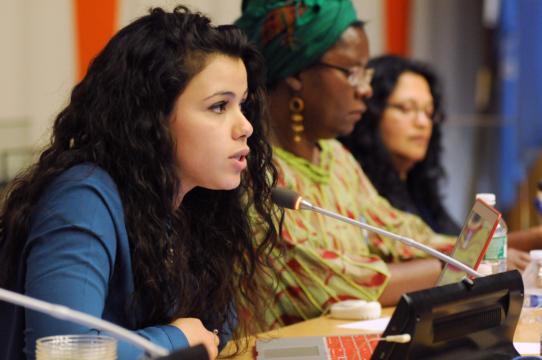What Roles are Women Playing in Mexico’s Drug War?
What roles are women playing in Mexico’s brutal drug trafficking war?
Only nine of the top 500 companies in Latin America were run by women in 2012, according to a Latin Business Chronicle analysis, and while a 2013 McKinsey study found that 37 percent of executives said that gender diversity was a priority for their company, few reported having women on the executive teams, with men and women differing significantly in their explanation for the lack of gender diversity. Why is there such a lack of women in powerful seats running companies or sitting on boards in the region? Where in the world have regions or countries been effective at addressing the glass ceiling, and are those practices appropriate for Latin America? Is there an opportunity for women to be the rule instead of the exception in the future? If so, what needs to change in the industry or education in order to help make room for future female executives?
Donna Hrinak, member of the Advisor board and president of Boeing Latin America: “While the numbers from Latin America are disappointing, they are regrettably also in keeping with statistics from around the world. For example, women hold only 4.6 percent of the CEO positions in the Fortune 500—actually down from 4.8 percent one year ago—and at the current rate of progress, women will reach parity with men in business leadership roles in 2085—just 70 short years from now! Improving this picture requires a combination of public policies, organizational practices and personal responsibility, working from both the bottom up and the top down. While gender quotas, such as those required for corporate boards in countries including Norway and Germany, are controversial, they can be useful transitional measures. Requiring that women participate on corporate boards can help overcome the attitude some male managers express that they ‘would hire a woman (for a particular job), but just don’t know any.’ Executives should also pay attention to the research, which shows consistently that companies with more women on their boards and in their executive ranks have better results: higher returns on equity, more sales and greater return on investment. Including women in the executive ranks should be a business no-brainer. At the same time, women who aspire to business leadership—and their partners—must accept that while the modern women’s movement has given us more choice to work outside the home, to drop out of the work force for child-raising, to accept or decline an overseas assignment, choices have consequences. One course might be to stop thinking about work-life balance, and instead focus on work-life integration, deciding how career choices fit with overall values and interests.”
Elena Viyella de Paliza, president of Inter-Química in Santo Domingo and member of the Inter-American Dialogue: “More developed regions like North America and Europe have been more successful because they started working on including women in positions of power earlier than did Latin America. Nevertheless, Latin America is changing and more focused in the corporate world on bringing women into positions of leadership. The strongest glass ceiling is the one we self-impose on ourselves. The other one is cultural, and it is different in every country and region. It is about the way we raise our girls and the expectations we have. The weight of bringing up children is on women, requiring more of their time and dedication, which either pushes their careers back, imposes additional burdens or forces women to make choices. This is a filter in itself, and an important one, as no woman wants to fail to take proper care of her children due to a career. And this is even more true in Latin America due to the culture. Those of us who want to have both a family and a productive career have choices to make. I did not want to give up having a family and caring for my kids, which takes a toll on health, time, dedication and, of course, sleep. But you need a supportive husband who supports your goals. Therefore, we need to make sure women continue to educate themselves as much as possible, facilitate educational opportunities, help them understand the importance of choosing their partner well and make them conscious of what they want to become. The corporate world needs to understand that there are tradeoffs, but that it is worthwhile to make sure they value women equally and take them into serious consideration when they hire, promote and choose leaders. Last but not least, the ‘macho’ culture is still an issue. Even though I do not think it is so true anymore, I asked several successful businessmen if they thought that this was still a factor, and their answer was that it is. So we also have to work on the culture to make a difference for women.”
Fernanda Vicente, president of Mujeres del Pacífico, executive director of Diverge, Business Innovation Center, and founder of Inittia: “Women need a lot of determination to get to the top of companies in Latin America. They have to fi ght against a male environment and rules, they have to fi gure out how to manage their professional life and their family life, and they also need a partner who supports their success. Latin men are learning, but they come from centuries of machismo. I think we have double challenge, to be successful in our careers and in our relationships. We are a generation that is teaching our partners, our husbands, how to deal with female success. Maybe some countries in Europe, like Germany, or North America have been successful, but copying models is tricky. Our culture is different. We need to fi nd our own model, and we should design this model with men. This is a conversation between males and females about the roles we deserve and are ready to take. We are living in a unique time in Latin America where we are building the future together based on a new paradigm. There is absolutely an opportunity for women to be the rule instead of the exception. Our generation knows very well what we want and what we need, and we are ready. We are not afraid of taking risks and are thrilled to face new challenges. We have the mission of bringing our region to the next level. We know that we have the future of Latin America in our hands. In 10 years, you will see outstanding data on women on boards and running companies. First, we need to educate our men from childhood on how to deal with and support female success. Second, companies need to be ready for this new generation of women that come to transform society. We will build companies that make a triple impact (social, economic and environmental), and this fact will bring many benefi ts to organizations. Third, we need to communicate to our girls that they have the power to change our countries, and they have the responsibility to take opportunities and co-create the future with the men.”
Sylvia Maxfield, dean of the Providence College School of Business: “The percentage of women on boards is creeping up thanks to a growing understanding that diverse boards are good boards. Why is progress so slow? We all carry biases with us in our daily lives, shaped by experience and a primordial instinct to protect ourselves against group outsiders. It takes a very concerted effort to overcome these biases. I am not sure that the kind of legal mandates imposed in some European countries help get at the root of the problem. We know that women want to sit on boards, and that there are plenty who are qualifi ed to be outside directors. Women and men in powerful roles should make sure to encourage their colleagues to search broadly and outside their networks for new board members.”
Marc Andersen, principal and EY’s international government & public sector leader: “Women account for more than half of the world’s population, but are continually overlooked as a vital talent resource. The 2015 World Economic Forum (WEF) forum on Latin America highlighted cultural and corporate barriers to closing the gender gap in Latin America and the Caribbean. We believe that companies play an important role in breaking those barriers by creating effective internal and external programs focused on women’s advancement and leadership. This approach has been critical to our success as a global organization determined to build a better working world. A growing body of research, including a new survey EY commissioned from Longitude Research surveying leaders of 400 companies in response to an October 2014 report from the WEF, suggests that women’s advancement in the workplace and gender balance on teams, boards and governments are critical for producing better outcomes and creating greater prosperity. EY has brought all our efforts together to create one unifying accelerator—Women Fast Forward. This program leverages our collective knowledge, experiences and convening power to push ourselves further and to do our part to accelerate global gender parity. EY is also proud to be a part of one such initiative with the U.S. Department of State- EY partnership on TechCamps designed to support women entrepreneurs in Colombia, El Salvador, Bolivia and Argentina. Upon program conclusion, there is mentorship for the select fi nalists. EY is also working with the Inter-American Development Bank to make the business case for gender investments in Latin America and the Caribbean’s private sector. We encourage other market players to do their share in advancing the women’s equality agenda in the region.”
The Latin America Advisor features Q&A from leaders in politics, economics, and finance every business day. It is available by subscription to members of the Dialogue's Corporate Program.
What roles are women playing in Mexico’s brutal drug trafficking war?
To what extent have the policies of President Juan Manuel Santos helped or hindered businesses in Colombia?
How are women faring in Latin America? Where has progress been made and how has that been achieved?


